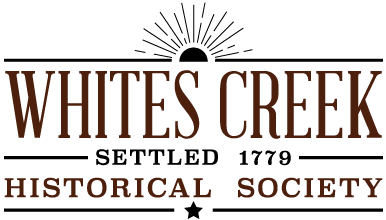Zachariah White came from Pennsylvania to North Carolina. White had worked as a millwright in Pennsylvania where he had a wife and family. In 1778, he travelled with a party led by James Robertson going west over the Cumberland Mountains. Others in the party were George Freeland, James Freeland, William Neely, William Overall, William Fletcher, James Harris, Mark Robertson, Edward Swanson and Cornelius, a slave of James Robertson.
According to Founding of Cumberland Settlements, Volume 1, “they planted a field of corn on the ground where Nashville now stands…and the party returned to East Tennessee for their families, leaving Overall and White and Swanson to keep the buffaloes out of the corn.” .”[1]
Edward Swanson documented daily activities of James Robertson’s group and this information along with other eye witness accounts is published in Paul Clements Chronicles of the Cumberland. In this text Swanson states “Whites Creek and Whites Bend were named for Zachariah White”. [2] White, serving as a school teacher at the French Lick fort met his fate on April 2, 1781.
As more and more settlers had moved into this fertile land that teemed with buffalo, deer, and elk, the Native Americans felt threatened that what they had used as hunting ground would be taken from them. In 1781 the tension between the Native Americans and the settlers escalated at the Battle of the Bluff. Edward Swanson documented details of April 2, 1781:
The Indians had kept up the fight until they were within 30 or 40 yards of the fort. The whites who survived got into the fort by the little doors on the southeast end, and from the port holes we commenced a fire which we kept up till 10 o’clock. The Indians retreated precipitately, carrying their dead with them, two excepted. The Indians lost about 40 warriors – afterwards ascertained by prisoners. We lost six men killed and two wounded.
George Kennedy died on the ground and was scalped…One of the ten rein- forcements, Zachariah White, aged about 50, was shot through the bowels, but escaped into the fort and died the same day about sunset…
That day was employed in burying the dead and repairing the fort, and the next day was also employed in repairing the fort. About nine o’clock in the night, the fort was again attacked by another party of about 200, principally Creeks as was supposed. [3]
[1] Founding of the Cumberland Settlement. Doug Drake, Jack Masters, Bill Puryear. Warioto Press, 2009.
[2] Chronicles of the Cuberland, Paul Clements, Self published, 2012. www.chroniclesofthecumberland.com
[3] Idem.
These and other historical books can be found at http://www.eldersbookstore.com/ and
